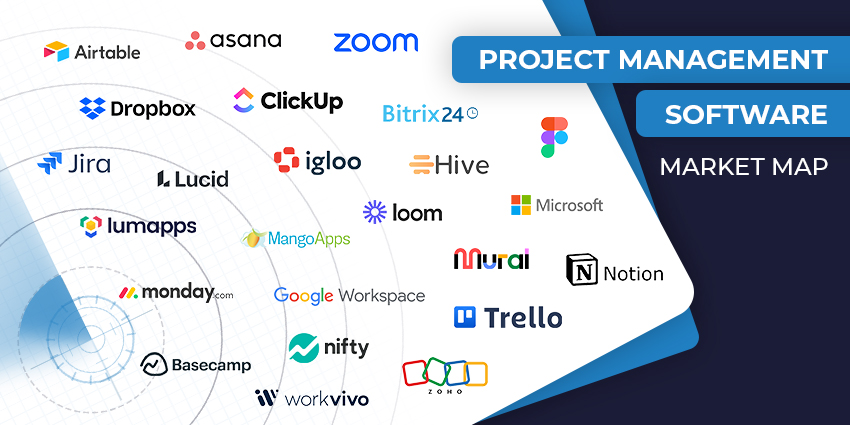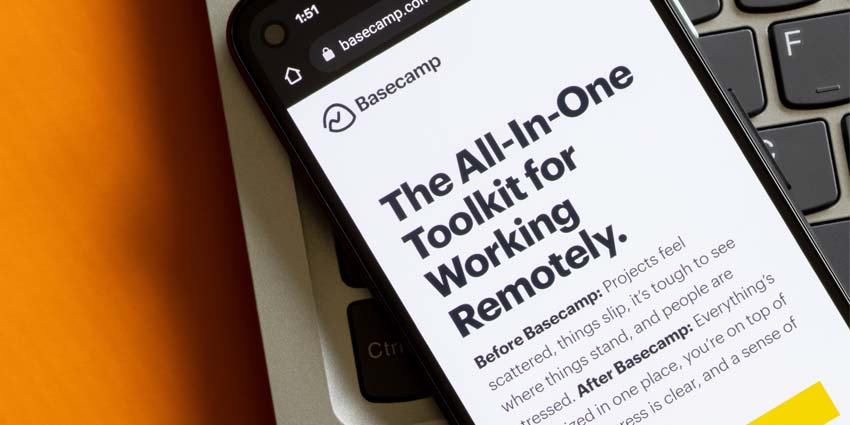In an evolving workplace, effectively managing hybrid and remote teams has become increasingly complex. Companies aren’t just struggling with knowledge sharing, or data security. They’re facing unique challenges keeping teams aligned, productive, and engaged. That’s where Collaborative Work Management (CWM) solutions step in to revolutionize teamwork.
Collaborative work management, a market currently growing at around 16% per year, offers companies the combined tools and resources they need for workplace planning, collaboration, automation, monitoring, and team engagement.
It’s not just about enabling asynchronous collaboration or giving teams a central hub where they can chat about tasks. CWM is about providing every team with a cohesive platform for creativity, innovation, and aligned growth. So, how will collaborative work management shape the future of work? Here’s everything you need to know.
What is Collaborative Work Management?
Collaborative Work Management (CWM) is defined by analysts like Gartner as the market for standalone software solutions that provide task-driven workspaces to distributed teams, allowing them to plan, automate, and cooperate on projects. To put it another way, CWM solutions are all about prioritizing real-time alignment between all employees in a digital space.
While facilitating collaboration has always been important for businesses, a systematic approach to collaborative work management has become more crucial lately. After all, even as modern companies try to nudge employees back into the office, the future of work is still flexible.
As hybrid and remote work take over, CWM solutions encourage companies to switch from strict top-down hierarchies to team-centric methodologies, inviting everyone to contribute actively to business goals. Part of what makes collaborative work management tools so effective is their adaptability. When teams are stretched across different time zones and schedules, CWM solutions centralize information and help communication flow smoothly.
CWM tools bridge geographical divides, ensuring that all team members, regardless of location, have access to the same information and resources in real time. They boost productivity, enhance accountability and transparency, and minimize bottlenecks.
How Collaborative Work Management Differs from Project Management
So, how is all of this different to standard “project management”. Traditional project management is often laser-focused on bringing in a specific project on time, on budget, and on spec. It’s all about ticking boxes and adhering to rigid deadlines.
Collaborative Work Management (CWM) takes a broader approach, extending beyond just major projects to include the day-to-day activities, workflows, and micro-tasks that keep your organization running smoothly. CWM encompasses the whole organizational spectrum, ensuring everything from big projects to routine tasks run smoothly.
Plus, unlike traditional project management, which mostly focuses on allowing companies to assemble dedicated teams for specific projects, CWM extends across teams. It allows multiple departments to collaborate in real-time, in a single platform, without silos.
There are no location-specific collaboration software or apps, no tools that deliver different features to employees scattered through departments and systems. The focus is on synergy, collective productivity, and bridging gaps.
The Features of Collaborative Work Management Tools
Just like most platforms designed to support the “future of work”, collaborative work management tools are quickly evolving. The latest solutions feature omnichannel communication tools, rich workflow automation capabilities, and even intelligent assistants.
While the central features of different platforms vary, most solutions include tools for:
Task and Project Organisation
CWM tools make assigning tasks a breeze, whether you’re using Kanban boards or Gantt charts. Trello and Asana, for instance, let you track tasks visually, giving you an instant pulse on what’s happening and who’s responsible.
Real-Time Communication and Collaboration
Say goodbye to never-ending email chains. Chat functions, comments, and instant notifications allow teammates to resolve questions on the fly. Plus, multiple people can tweak the same document without versioning issues. Teams can even communicate through video, audio, and other methods.
File Sharing and Document Management
With collaborative work management tools, teams can stop wasting time hunting for the correct file across disparate storage services. CWM solutions centralize file access and let you collaborate seamlessly, with built-in version control and integrations for platforms like Google Drive.
Workflow Automation
CWM tools can automate reminders, assign tasks based on triggers, and shuffle projects along the pipeline. Monday.com, for example, offers straightforward automations that keep teams on track without endless manual input.
Integration with Artificial Intelligence (AI)
AI is the future, and it’s already making waves in CWM. Some platforms automate content generation, while others provide smart recommendations on task prioritization. AI can even create intuitive meeting transcripts into ready-to-use templates.
Booking and Scheduling Tools
Avoid back-and-forth scheduling nightmares by using built-in calendars and resource booking modules. Some solutions, like Microsoft Places, even use AI to help employees identify the best rooms to book, and the right times to visit the office based on their goals.
Insights and Analytics
Collaborative work management tools help businesses and team members track crucial metrics. They feature real-time dashboards that can be tweaked to monitor specific performance indicators, time-tracking tools, productivity insights, and more.
Mobile Accessibility
Because work doesn’t stop the moment employees leave their desks, most collaborative work management tools now feature mobile apps. This ensures team members can reply to comments, check project updates, upload documents, and more on the move.
Security and Access Controls
Every organization has confidential information that must remain under lock and key. Leading CWM platforms offer encryption, multifactor authentication, and customizable permission levels to protect sensitive data while enabling fuss-free collaboration.
The Benefits of Collaborative Work Management Solutions
So, what makes collaborative work management solutions so crucial to today’s teams? On a broad scale, they simply make management easier in a world of hybrid and remote work. CWM tools ensure companies can orchestrate and empower teams across multiple time zones and locations, keep teams motivated, and ensure projects are completed on schedule. Key benefits include:
Increased Accountability
Keeping track of “who’s doing what” can be overwhelming, particularly when you can’t simply lean over and chat with your colleague across the desk. CWM tools eliminate the guesswork by placing every task, owner, and deadline in plain view. This boosts accountability, ensuring distributed teams are constantly living up to business expectations.
Enhanced Transparency
Transparency is crucial to building trust and team spirit – but it can be hard to maintain in a distributed workforce. Collaborative work management tools centralize everything from task progress to meeting notes and AI suggestions into one platform, accessible by everyone. When decisions are based on real-time, shared data, growth in an organization happens faster.
Greater Efficiency
Employees and businesses are sick of wasting time on mind-numbing repetitive tasks. Modern CWM solutions automate those chores, so staff can channel their energy into innovation. Most of the top tools come with built-in automation solutions for everything from meeting summarization to notifying colleagues about task changes and boosting efficiency.
Empowered Hybrid Teams
As mentioned above, one of the best things about collaborative work management tools, is they’re designed specifically to align distributed teams. With seamless solutions for mobile notifications, video conferencing, collaborative document editing and chat, scattered teams are more connected. Remote team members don’t feel like they’re left “out of the loop”.
Reduced Costs
Implementing CWM solutions can help businesses access significant cost savings. They reduce reliance on various applications with independent licenses. Instead, you get an all-in-one solution that includes everything you need to manage and motivate teams. Collaborative work management platforms ensure businesses can accomplish more with less.
Stronger Communication
If you’ve ever had to dig through a mountain of old emails to confirm a single detail, you’ll appreciate CWM’s consolidated approach to team messaging. Real-time chat, threaded comments, and live editing ensure every important piece of feedback remains organized, visible, and actionable. It’s the difference between aimless back-and-forth and lightning-fast collaboration.
Centralized Data Access
Few things slow down a project like searching for the right document or the correct spreadsheet version. CWM platforms store all files in one place, ensuring nobody is left rummaging through old emails for attachments. Plus, they make it easy to track important metrics and make data-driven decisions for growth. With data encryption and user permissions, you can also rest easy knowing sensitive information is kept secure.
Choosing Collaborative Work Management Tools: Top Tips
As the workplace continues to transform, countless leaders have emerged in the CWM space, from well-known organizations like Wrike, Airtable, and Monday.com to niche players like QuickBase with their AI-powered management platform.
There’s no one-size-fits-all strategy for success, but there are a few things you should be focusing on as you sort through your options, such as:
- Integration capabilities: Seamless integrations are a most for a collaborative work management platform. Make sure you can hook in your existing email, chat, storage, video conferencing, even CRM systems.
- Comprehensive Reporting and Analytics: To continuously refine your processes, you need solid data. Look for platforms with easy-to-customize dashboards, real-time analytics, and in-depth reporting. AI-powered insights and predictive analytics are a bonus.
- Scalability: As your organization grows, your CWM tool should be able to adapt seamlessly to new requirements. Make sure you can add more users, scale up resources, tweak workflows, and experiment with new features without roadblocks.
- Simplicity: If your software solutions and platforms are difficult to use, your employees won’t bother to use them. Choose a solution that feels intuitive to use from day one, so your team members can hit the ground running without extra training.
- Security features: In a hybrid world, security and compliance issues can be tricky. Make sure your solution offers end-to-end encryption, two-factor authentication, access-based controls, and options that help you adhere to industry standards.
- Customization options: Every workflow is unique, so ensure your chosen tool can adapt to your unique processes. Make sure teams can customize their dashboards, access mobile-friendly tools, and build their own workflows.
Collaborative Work Management Trends: The Future of Work
The future of work is changing all the time, meaning collaborative work management tools need to constantly adapt and evolve too. As we head into the next era of the modern workplace, here are some of the major trends shaping cutting-edge CWM solutions.
1. More Flexible Work Solutions
The days of spending a set number of hours a day in a specific office location are over for most team members. Although some companies are tightening return-to-office policies, most are prioritizing flexibility with hybrid set-ups, four-day workweeks, and office neighborhoods.
CWM solutions are adapting to these new environments, introducing new solutions for simple asynchronous work, room and desk booking, schedule management, and more. For instance, Microsoft Places now makes it easy for teams to optimize their schedules with AI.
2. Increasing Tool Consolidation
With digital work exploding, employees often juggle up to 11 apps a day, and productivity suffers as a result. Fragmentation kills efficiency, and CWM solutions are becoming more flexible to address this issue. They’re integrating seamlessly with a range of new platforms, from workforce management tools, to CRM solutions and contact centers.
CPaaS offerings are becoming increasingly popular, too, allowing businesses to embed CWM solutions into applications and add their own features, like AI assistants and other tools. Increased integration options and APIs lead to a more centralized work environment for digital teams.
3. The Rise of Artificial Intelligence
AI solutions are revolutionizing virtually every workplace process and system – including collaborative work management platforms. Companies like Asana and Trello are introducing AI tools that can help businesses plan out projects, assign tasks, create content, and summarize meetings.
Some organizations are even beginning to experiment with agentic AI solutions that can act as digital team members, completing a wide range of tasks in tandem without human input. Although the rise of AI introduces potential security and ethical concerns, the opportunity to boost productivity is massive.
4. The Evolution of Meetings
While many leading collaborative work management platforms focus more on chat and messaging than video conferencing, some are beginning to implement their own video conferencing features. These solutions are becoming increasingly advanced, with the introduction of AI solutions for real-time transcription and automated summaries.
Gesture recognition and speaker tracking are helping to enhance engagement levels in meetings too. This leap in quality and engagement drastically improves “meeting equity,” ensuring every participant has a voice, whether they’re remote or on-site.
5. Immersive Technologies
Augmented Reality (AR) and Virtual Reality (VR) are no longer sci-fi fantasies—they’re beginning to reshape how distributed teams ideate and build products. AR overlays and VR meeting rooms allow participants to interact with 3D models or experiment with training scenarios anywhere.
Some companies are even experimenting with holographic telepresence, imagining a future where remote colleagues appear nearly lifelike in the conference room. These immersive approaches aim to replicate the spontaneous, creative spark that can be missing in standard virtual calls.
6. Optimized Data-Driven Insights
Given the sheer volume of conversations, tasks, and content swirling around a digital workspace, the potential for gleaning insights is massive. Advanced analytics can now measure not just output but team engagement, sentiment, and collaborative patterns.
By crunching the data and leveraging predictive analytics, businesses can pinpoint who needs extra support, which processes are slowing things down, and how best to allocate resources. In short, the more you measure, the faster you can innovate.
7. Upgraded Security Measures
As collaborative work management tools become more crucial to organizations, they’re also becoming prime targets for cyber threats. The surge in data-sharing – especially with AI in the mix – heightens risks around privacy, data leaks, and security breaches.
Top-tier platforms are investing in end-to-end encryption, advanced permission levels, and rigorous system audits to stay ahead of hackers. For many organizations, being able to demonstrably protect sensitive information can be a deciding factor when choosing which CWM platform to trust.
8. Wellbeing and Continuous Learning
Burnout is a real issue, and savvy employers know it can torpedo productivity and morale. Modern CWM solutions often include features to monitor workload distribution or even provide gentle nudges when employees are buried under tasks.
Some platforms integrate learning modules so staff can upskill without leaving the project environment. This holistic approach goes beyond mere project tracking; it helps nurture a healthier, more resilient workforce.
The Future of Work with Collaborative Work Management
The rules of workplace engagement are changing as office environments continue to evolve. Collaborative work management tools are emerging as the glue that binds teams together across distances and schedules. Being out of the office no longer means being out of the loop.
With the right platform, everyone can share knowledge, spot hurdles, and cooperate to achieve business goals. Cutting-edge CWM solutions give organizations all of the tools they need to stay one step ahead of the competition, enhance corporate culture, and improve engagement.
Ready to revolutionize how you align, synergize, and empower your teams? Check out our guide to solving the five top hybrid work challenges with CWM solutions. Alternatively, prepare your team for ongoing success with our tips for maximizing the ROI of CWM platforms.







